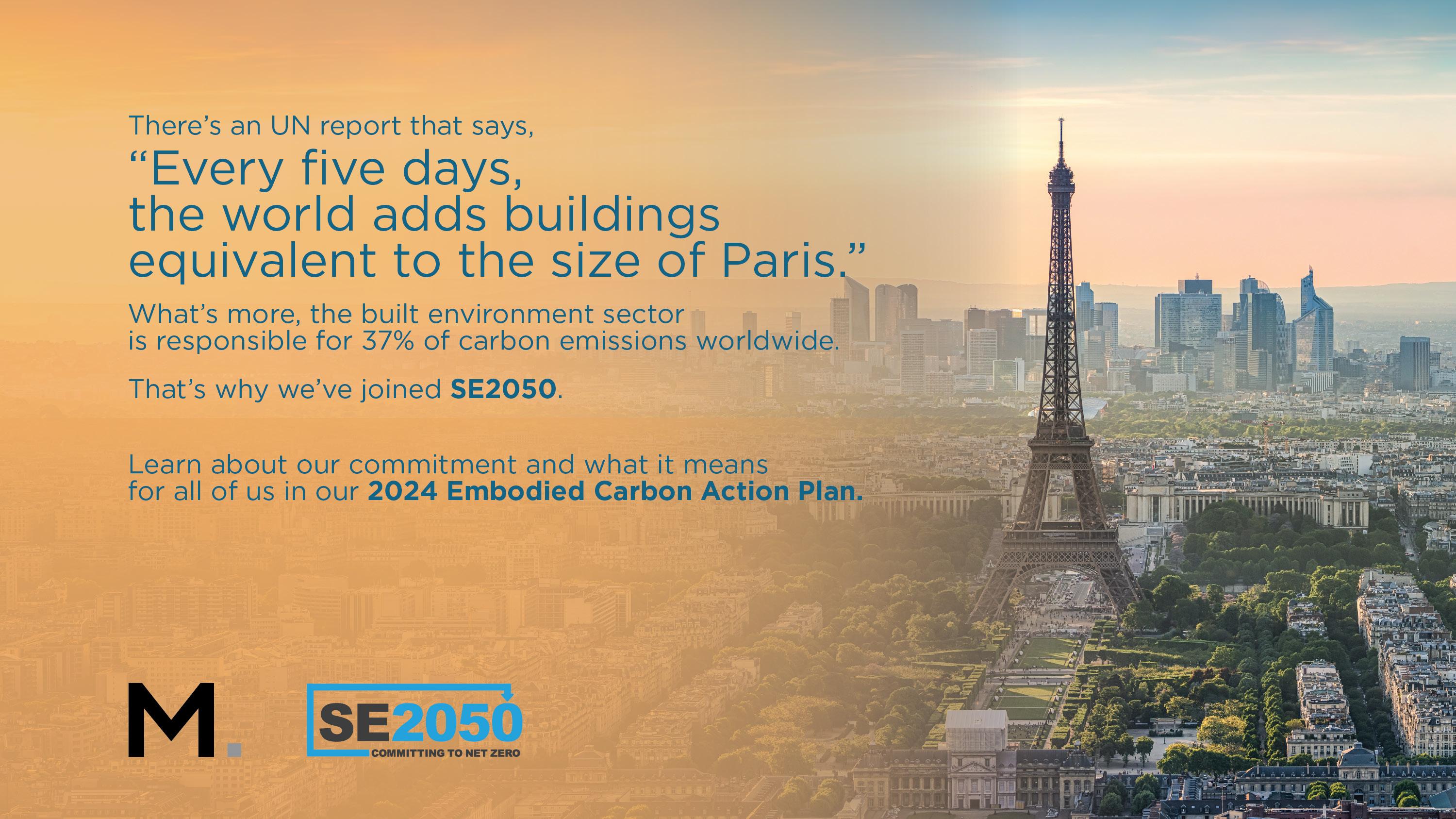Mackenzie SE 2050 Embodied Carbon Action Plan 2024


Introduction
As members of the design profession, we have both the responsibility and the opportunity to reduce the built environment’s impact on global carbon emissions.
Mackenzie’s vision as a design firm is the unified pursuit of building equitable communities for generations to come. As part of this overarching mission, it is essential that we hold ourselves and our profession accountable in achieving climate goals.
In 2023, Mackenzie joined the Structural Engineering 2050 (SE 2050) Commitment as well as the American Institute of Architects 2030 Commitment (AIA 2030), formally committing to reduce operational and embodied carbon (EC) in our projects.
Jo Ann is a structural designer at Mackenzie with eight years of experience. She also chairs the Structural Engineers Association of Oregon Sustainable Design Committee.
The Embodied Carbon Champion’s primary role will be educating staff on the importance of reducing embodied carbon and providing staff with the resources to meet our firm’s goals.
She will stay informed on best practices in EC accounting and reporting, and track the development of EC policies in our region, keeping staff informed of policies that will affect our projects and educating staff on all compliance pathways.
 Jo Ann Offill Embodied Carbon Champion
Jo Ann Offill Embodied Carbon Champion
6
1 Page 2 1 Intro
2 Education
3 Reporting
4 Reduction
5 Advocacy
Embodied Carbon Action Plan 2024
Elective Documentation
Why 2050?
Scientists agree that by limiting the average global temperature to a threshold of 1.5° Celsius above preindustrial temperatures, we can significantly reduce the risk of serious and irreversible impacts due to climate change.
To stay below this threshold, scientists have recommended two goals:
Cut emissions 45% by 2030 (from 2010 levels)
Achieve net-zero emissions by 2050.
According to the UN, the Buildings and Construction sector accounted for more than 37% of worldwide energy and process related CO2 emissions in 2021*.
While many stakeholders have begun efforts to reach net-zero by 2050, recent reports suggest that we will surpass the 1.5°-threshold sooner than expected, illustrating an urgent need to reduce emissions quickly.
Why Embodied Carbon?
Embodied carbon is the measure of all emissions throughout a project’s lifecycle. It includes everything from raw material extraction, manufacturing, transportation, construction and installation, as well as maintenance and disposal.
While operational carbon emissions are generated over the lifecycle of a building, the majority of embodied carbon emissions are generated upfront before the building is in use. Because embodied carbon emissions are generated at the beginning of a building’s lifecycle, there is great potential to cut emissions in the short term.
Our structural engineers are committed to understanding, reducing, and achieving net-zero embodied carbon in our projects by 2050.
*“CO2 emissions from buildings and construction hit new high, leaving sector off track to decarbonize by 2050”, UN Environment Programme, press release, 11-9-22


Page 3 Embodied Carbon Action Plan 2024
Commitment Letter 1
September 21, 2023
Mackenzie
Attention: Laura Champion, Director, Structural Engineering Institute
Re: Letter of Commitment to the SE 2050 Program
Dear Laura:
Mackenzie, a 208-person firm with offices located in Portland, OR, Seattle, WA, and Vancouver, WA, is hereby signing on to the SE 2050 Commitment Program. We support the vision that all structural engineers shall understand, reduce, and ultimately eliminate embodied carbon in their projects by 2050.
Mackenzie is invested in our people, our clients, and the communities in which we work. We believe design is an inclusive process where diverse perspectives are valued. Our solutions consider context, identity, function, economic viability, and the environment.
We have been guided in recent years by our sustainability statement: “Mackenzie invests with our communities in stewardship of our shared planet. We respect the ecosystems around us. We recognize our duty to improve wellness for all. We design a better built environment for today and future generations.”
Our firm has a longstanding commitment to sustainable design, and a portfolio of projects that have achieved the full range of LEED and Green Globes certifications. However, we have determined that to meet the challenges of a changing world, we need to push ourselves further. We believe that the SE 2050 Commitment will provide the third-party rigor, transparency, and metrics we need.
The SE 2050 Commitment offers a platform to better integrate decision-making on carbon impacts into our everyday design process, and lays the groundwork for structural engineers to actively improve sustainability and performance across all phases of our projects. It offers tools in accountability, quantifiable results, and a vision to pitch to clients. We are very excited to take this step forward
We therefore commit Mackenzie to take the following steps which are part of the SE 2050 Commitment Program: Within six months and annually henceforth, we commit to reporting an Embodied Carbon Action Plan (ECAP) and permit the ECAP document or form be made public on the SE 2050 website.
Within one year and annually henceforth, we commit to submit data to the SE 2050 project database in a collaborative effort to understand embodied carbon in structural engineering projects and to set attainable targets for future projects.
We look forward to joining this coalition and industry effort to achieve the goals of the SE 2050 Program. Sincerely,
Tim Schweitzer PE, SE Associate Principal | Director of Structural Engineering

Continued Page 4 Embodied Carbon Action Plan 2024
P 503.224.9560 F 503.228.1285 W MACKENZIE.INC RiverEast Center, 1515 SE Water Avenue, #100, Portland, OR 97214 ARCHITECTURE INTERIORS STRUCTURAL ENGINEERING CIVIL ENGINEERING LAND USE PLANNING TRANSPORTATION PLANNING LANDSCAPE ARCHITECTURE Portland, Oregon Vancouver, Washington Seattle, Washington
2 Education
Mackenzie believes that educating employees on embodied carbon is a fundamental step towards achieving our ultimate goal of net-zero carbon by 2050. Our Education Plan outlines our strategy for engaging our engineers and empowering all staff to work towards the goals of the program.

At this time, there are very few jurisdictions that mandate the reduction of embodied carbon emissions, instead focusing on operational carbon and energy efficiency standards governed by energy codes.
Over time, implementation of energy standards will lead to significant reductions in operational carbon, and embodied carbon will become a much larger portion of a building’s total carbon footprint. It is important that our engineers understand the role that they play in reaching carbon neutrality and the impact that can be made by specifying the right materials and using them efficiently.
EMBODIED CARBON LIFE-CYCLE
The Plan
Initial Efforts
The 2024 Embodied Carbon Action Plan (ECAP) will be introduced to engineering staff in a department-wide presentation.
The EC Champion will develop a resource library available to all staff that contains best practices on carbon accounting and reporting.
Onboarding of new staff will include training material on embodied carbon, as well as an overview of the SE 2050 Commitment and the firm’s current efforts for reducing embodied carbon as outlined in the ECAP.
Each year, we will continue to educate all staff, not just structural engineers, on embodied carbon, keeping staff informed of best practices and policy and/or code updates in our region.
Engineering staff will commit to attend a minimum of one webinar annually.
Page 6 Embodied Carbon Action Plan 2024
EXTRACTION TRANSPORTATION CON STRUCTION MANUFACTURING OPER ATIONAL USE DEMOLITION DISPO SAL OR RECYCLING
Note From EC Champion
2Continued
Education
The EC Champion and/or members of the sustainability team will attend webinars/seminars more frequently and disseminate information to engineering staff as needed.
Each year, we will update staff on data gathering efforts, progress towards the SE 2050 goal, and future goals for carbon reduction.
An annual firm-wide presentation will feature a high-level summary of progress towards SE 2050 goals and a future outlook.
An annual department-wide presentation will take a deeper look at data collection from the previous year and how that data will be used to inform future reduction goals.
Firm-wide, EC becomes an important data point to help make decisions early in the design process.
Firm communications staff will collaborate with structural engineering staff to create media and materials about EC. See the Advocacy section for more details.
Education Timeline
Embodied Carbon Research
Research into and firm-wide presentation on low-carbon concrete, mass timber, and miscellaneous strategies for reducing embodied carbon in structural materials.
Create video series with firm communications staff.
2022 & 2023
Department Presentation
Presentation to engineering staff to introduce the Embodied Carbon Action Plan & SE 2050 Goals
Summer 2024
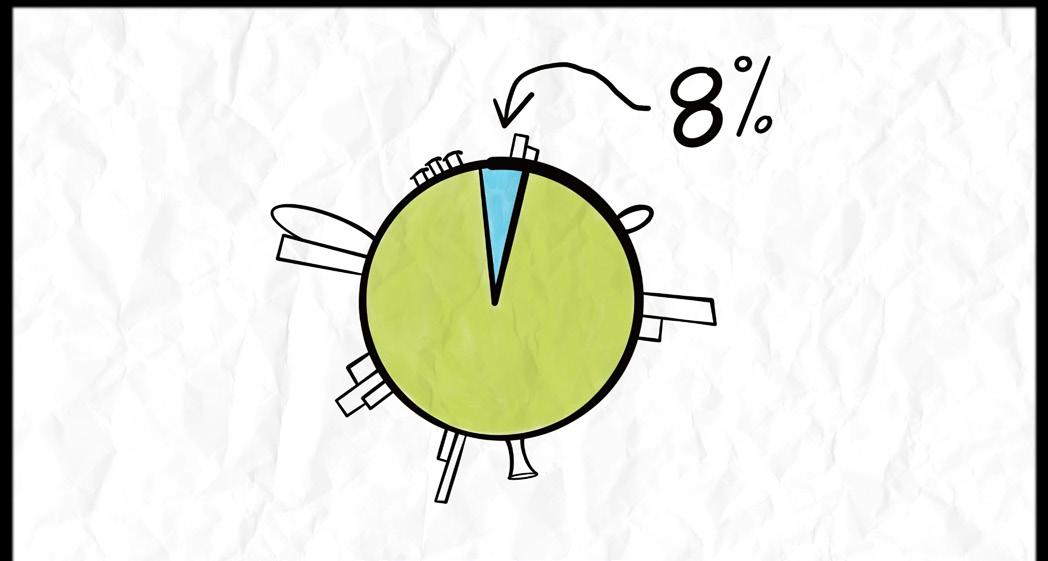
As part of our Education Plan we produced a short video on the impact of cement production on global emissions and how Portlandlimestone cement can reduce them.
All-staff Presentation
Present life-cycle analysis (LCA) process and data gathering efforts
Discuss impacts to clients and the firm
Early 2025
Watch Now
Follow-up Department Presentation
Present findings from previous year of data collection and future plans
Discuss embodied carbon impacts of different structural materials and systems and methods for optimizing design
Provide update on SE 2050 tracking efforts
Mid-2025
2022
2023
2024
2025
Page 7 Embodied Carbon Action Plan 2024
3
Reporting
This Reporting Plan outlines how our firm will measure, track, and report EC data. Measuring the EC of structural materials is the first step to understanding the impacts of various structural systems, and the data that is gathered will help to inform future design decisions.
Methodology
Utilization of EPDs and Material Specifications
Embodied carbon of structural materials will be measured using published values from the 2023 Carbon Leadership Forum (CLF) North American Material Baselines Report. The report provides a snapshot of the state of Environmental Product Declarations (EPDs) for construction materials in North America, and baseline values represent an estimate of industry-average greenhouse gas (GHG) emissions for those materials.
Product-specific EPDs will be used if the product is known and an EPD is available. It is expected that most products will be unknown during design unless material specs include global warming potential (GWP) thresholds and/or the project includes requirements for obtaining EPDs. These requirements will not be considered until year two. See the Reduction Plan for more info.
Lifecycle Assessment Software
The tallyCAT Revit plugin will be used for estimating EC in projects during the construction documentation (CD) phase. The tool can measure EC based on CLF baseline values or product-specific EPDs from the Embodied Carbon in Construction Calculator (EC3) database. TallyCAT results will be compared with estimates from the design development (DD) phase and used to improve early design phase estimates.
Estimating EC by Project Phase
Measuring EC in Structural Materials
Estimating total project EC
Not required - Early EC estimates should be based on data collected from previous projects N/A
Schematic Design
Use
Product-specific EPD if available, otherwise use CLF Baseline values
Use
Design Development Construction Documents
Page 8 Embodied Carbon Action Plan 2024
CLF
preliminary member sizes to est. material quant. and calculate total EC without LCA software
baseline values
tallyCAT to export material quant. frm Revit model and calc. total EC using EC3 database
3
Reporting
LCA Scope
Only A1 – A3 scope emissions, otherwise known as ‘cradle-to-gate’ emissions, will be included in LCA results for the first year. Currently, excluding A4 (transportation) & A5 (installation) is consistent with industry practices, as the scope of many available EPDs includes only A1 – A3.
Each year, we will evaluate whether it is appropriate and beneficial to include A4 and/ or A5 scope emissions in LCA results. Inclusion will be based on feasibility, availability of data, and standard industry practices.
Data reported for SE 2050 will only include EC from structural materials; however, we will encourage other departments to measure EC of non-structural materials.
Best Practices
Each year, we will update our methodology for measuring EC and performing LCAs based on lessons learned from the previous year.
Consideration will also be given to best practices and guidance available from publications such as The Structural Engineering Institute (SEI) Prestandard for Assessing the Embodied Carbon of Structural Systems for Buildings.
Reporting Timeline
Five projects submitted to the SE 2050 database
Industrial & Public Projects
Prioritize project types that represent a consistent and repeatable portion of our firm’s business. We expect this to be a learning year for our engineers. Projects selected for reporting will be relatively simple so engineers can focus on understanding the LCA process and achieving accurate reults.
Submit up to 40% of new construction projects, but not less than ten.
Expand project types
2024
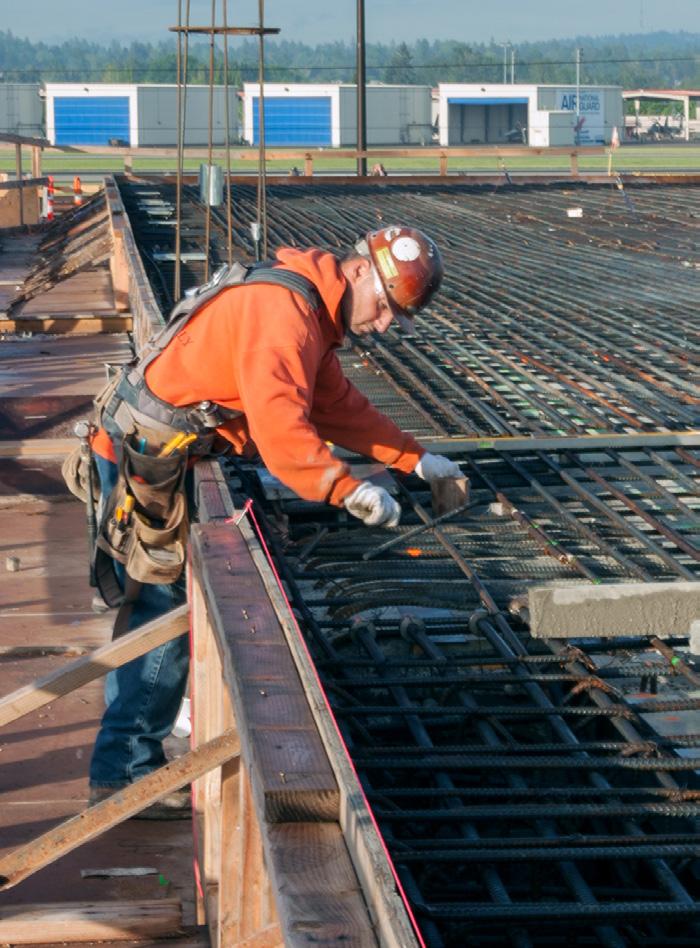
2025
Projects from other business units, including Retail, Adv. Tech & E-commerce will be considered for reporting. 2026
Submit a minimum of 50% of new construction projects. Projects from all business units
Page 9 Embodied Carbon Action Plan 2024
Continued
4 Reduction
The Reduction Plan outlines the actionable steps our firm will take to reduce embodied carbon in project work and reach our ultimate goal of achieving net-zero embodied carbon by 2050. The plan includes shortterm goals focused on education and data gathering, as well as specific and measurable long-term goals to meet reduction targets and assess progress along the way. We understand the importance of implementing large-scale changes in the way our firm approaches structural design beginning in early design phases and continuing through construction.
The Plan
Initial Efforts
We’ll start by educating engineering staff on EC in building materials and reduction strategies, including options for low-carbon materials and designing for efficiency. We will also adopt a mindset that considers the environmental impact of design decisions. From there we’ll establish baseline data for typical project types and structural systems, beginning with year one project data.
Embodied Carbon in the Unified Design Process
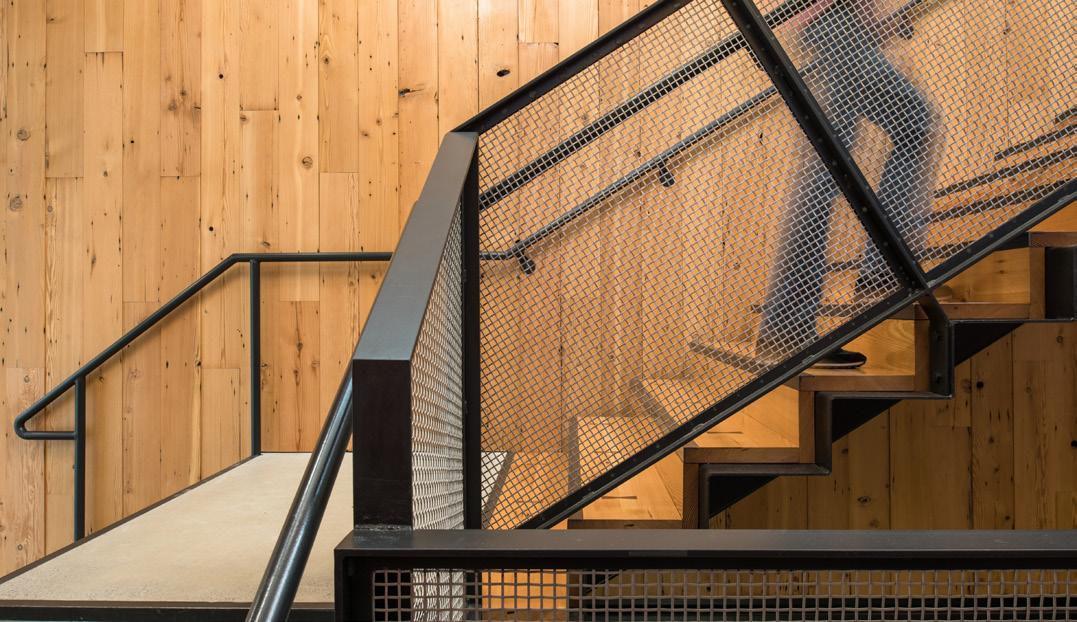
Next, we will insert embodied carbon data collection and reporting into Mackenzie’s firm-wide Unified Design Process. After enough data is collected during year one and year two, embodied carbon will be used as a metric when considering design options and structural systems during early design phases.
Reduction Timeline
Educate engineering staff on EC in building materials and reduction strategies.
Investigate low-carbon concrete mixes with Portland-limestone cement, including feasibliity, market availability & cost. Incorporate performance-based specifications for concrete mix design, and advocate for the use of low-carbon concrete mixes among contractors and clients.
Establish Baseline Data for structural systems and project types.*
Incorporate embodied carbon tracking into the Unified Design Process
Establish intermediate targets for reducing EC in projects by 2030 and by 2040.
Incorporate GWP limits for structural steel into specifications on select projects.
2024
*See Reporting Plan for more information.
2025
Page 10 Embodied Carbon Action Plan 2024
4
Continued
Reduction
Mackenzie’s firm-wide Unified Design Process shall also apply to a wholebuilding approach when designing to reduce operational or embodied carbon. For example, a design change that reduces operational carbon shall not impact the structural design in a way that results in a net increase in total carbon.
Reduction Goals
In year two, we’ll set long-term targets for overall and material-specific EC reductions. Each year, we’ll work toward our reduction goals by specifying less-impactful structural materials, designing for efficiency, and collecting and utilizing data to make informed decisions in regards to materials and structural systems.
Every five years beginning in 2030, we will take a deep look at our progress toward intermediate reduction targets to ensure we are on track for achieving net-zero by 2050.
Reduction Timeline Contininued
Begin using embodied carbon as a metric in early design decisions.
Expand number of projects where material specifications include GWP limits.

Every five years, check in on progress towards intermediate reduction targets and reflect on overall progress towards 2050 goal.
Achieve net-zero carbon in all projects by 2050
Page 11 Embodied Carbon Action Plan 2024
2026 2050
The design for One Main Place in Portland, OR utilized green roof to reduce water runoff and the heat island effects.
5
Advocacy
This Advocacy Plan details our firm’s strategy to communicate our embodied carbon reduction work externally, engaging with our clients, contractors, other design professionals and community.
The Plan
To start, we’ll publish our 2024 ECAP submission on Mackenzie’s company website. We’ll develop media and marketing materials regarding embodied carbon to be shared via multiple channels including social media and our website.
Next, we’ll encourage staff to participate in professional organizations that advocate for sustainable design within the engineering profession and prioritize embodied carbon education. We currently have staff on the National Council of Structural Engineers Association (NCSEA) and Structural Engineers Association of Oregon (SEAO) Sustainable Design Committees and expect to widen this type of participation.
We’ll continue to educate staff on the benefits of reducing embodied carbon and discuss messaging so that all employees can have informed conversations with our clients and advocate for reducing embodied carbon in our projects. Prompted discussions around client messaging will compliment all embodied carbon education.
As noted in the Reduction Plan, embodied carbon will be used as a metric in early design phases beginning in year three. At this time, we’ll develop tools that project teams can use to facilitate conversations with clients regarding the embodied carbon of different structural systems.
Advocacy Timeline
“The More You Know” video series. First video released about low carbon concrete.
2024 ECAP uploaded to company website
Company website’s “sustainability” page expanded to include:
SE 2050 commitment
Embodied carbon reduction goals
Summary of current and future efforts
2023
Second “The More You Know” video, about mass timber, released.
2024
Page 12 Embodied Carbon Action Plan 2024
Advocacy
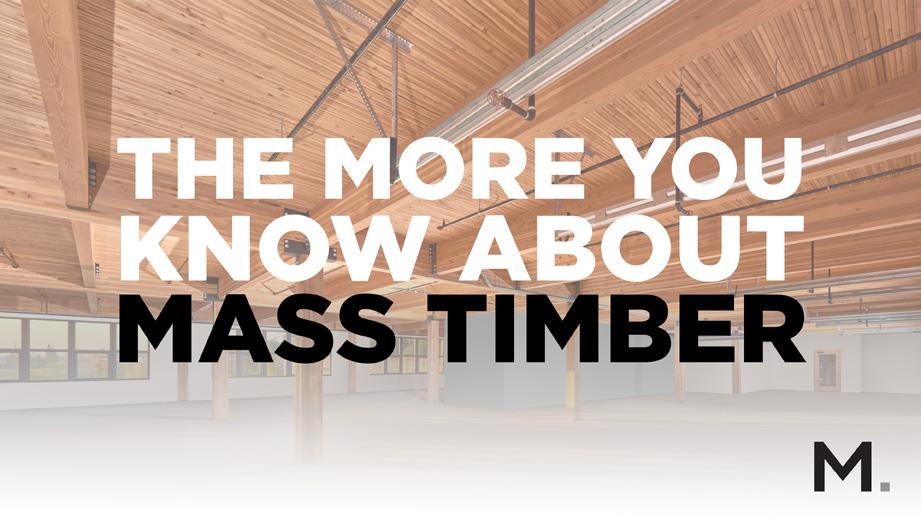
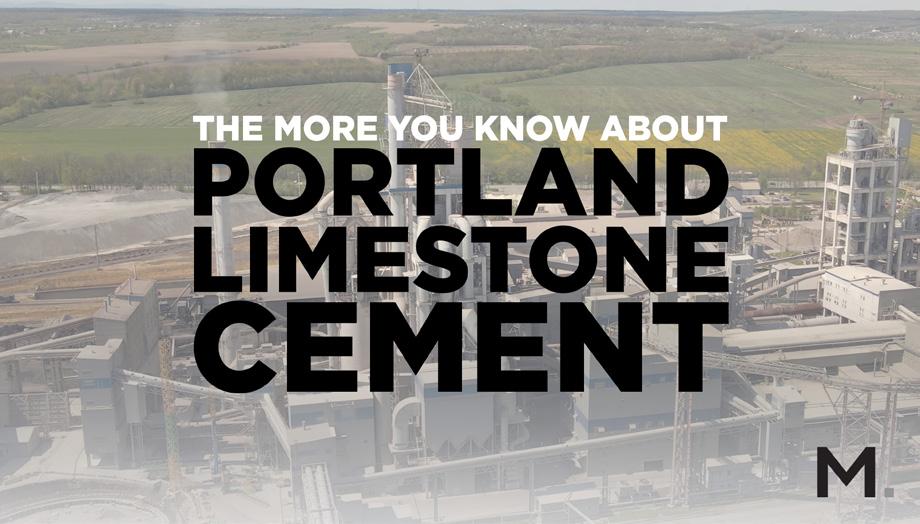
Sustainability in Structural Engineering Video Series
Mackenzie produced a video series featuring our structural engineers discussing topics related to sustainable design and embodied carbon.
These videos are posted on Mackenzie’s website and on our social media channels.
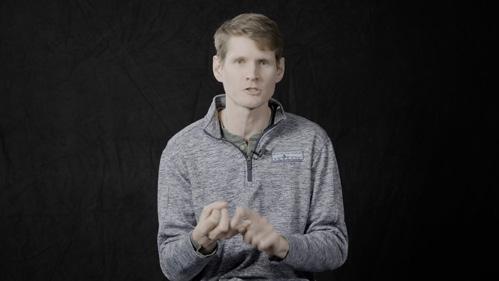

Advocacy Timeline Continued
Begin to develop tools to facilitate discussions with clients about EC of different structural systems.
2026 5
2025
Expand ongoing EC education for all staff to include strategies for client messaging
Continue to develop tools and visual aids that effectively demonstrate the EC impact of different structural systems. Tools can be used for internal education and external communication with clients and contractors.
Page 13 Embodied Carbon Action Plan 2024
Mass Timber with Rich Racz
Portland-limestone Cement with Jo Ann Offill Watch Now Watch Now
Continued
6 Elective Documentation
These are actions our firm intends to complete in the year of this ECAP submission based on ECAP electives offered. We will adjust our strategy based on what we learn each year.
EDUCATION: Two Required / Four Recommended
Required Electives:
9 Provide a narrative of how the EC Champion will engage embodied carbon reduction at each of our offices.
9 Present at least one webinar focused on embodied carbon and make a recording available to our employees. This could be created internally, pulled from an external source (with permission), or pulled from a publicly available source. Include this resource in orientation and on-boarding programs.
9 Optional Electives: Create an EC digital resource wiki and/or forum on our internal website for staff to create, share, and discuss EC educational resources.
REPORTING: One Required / Two Recommended
9 Required Electives: Submit EC data for a minimum of two projects per office to the SE 2050 Database. We are encouraged to submit as many projects as possible, but are not required to submit more than five projects across the firm.
Optional Electives: Work for the following elective will begin in year one, but will be completed in year two after first year data collection and reporting is complete:
Compare the EC emissions from multiple projects across our firm. Analyze and document what data or pieces of information are most important and communicate the findings to our firm.
REDUCTION: One Required / Four Recommended
Optional Electives:
9 Develop & implement a workflow that makes it easier to make early design decisions based on EC. The following electives will be implemented in year two after first year data collection and reporting is complete:
Compare different design options with EC as a performance metric during the project concept phase. Explain what was done and how the results changed.
Communicate the EC impacts of different design options to clients with creative and effective data visualization.
ADVOCACY: Two Required / Four Recommended
Required Electives:
9 Describe the value of SE 2050 to clients. How can our design teams collaborate to reduce embodied carbon? Attach any associated marketing materials.
9 Publicly declare our firm as a member of the SE 2050 Commitment (website, LinkedIn, or other social media).
Page 14 Embodied Carbon Action Plan 2024
About Mackenzie
Mackenzie is a design firm for the built environment. Over the past 63 years in business, Mackenzie’s services have evolved, and the firm now offers specialized services across a range of disciplines, including architecture, interior design, structural, civil and traffic engineering, land use and transportation planning, and landscape architecture.
Mackenzie’s integrated design approach skillfully navigates the entirety of a project, from studies and assessments to technical challenges and innovative solutions. Collaborative partnerships are integral to Mackenzie’s approach.
The firm proudly advocates for its clients to ensure every project achieves its goals and is delivered with the highest level of service. Mackenzie is in Portland, Oregon, and Seattle and Vancouver, Washington. For more information, visit mackenzie.inc.
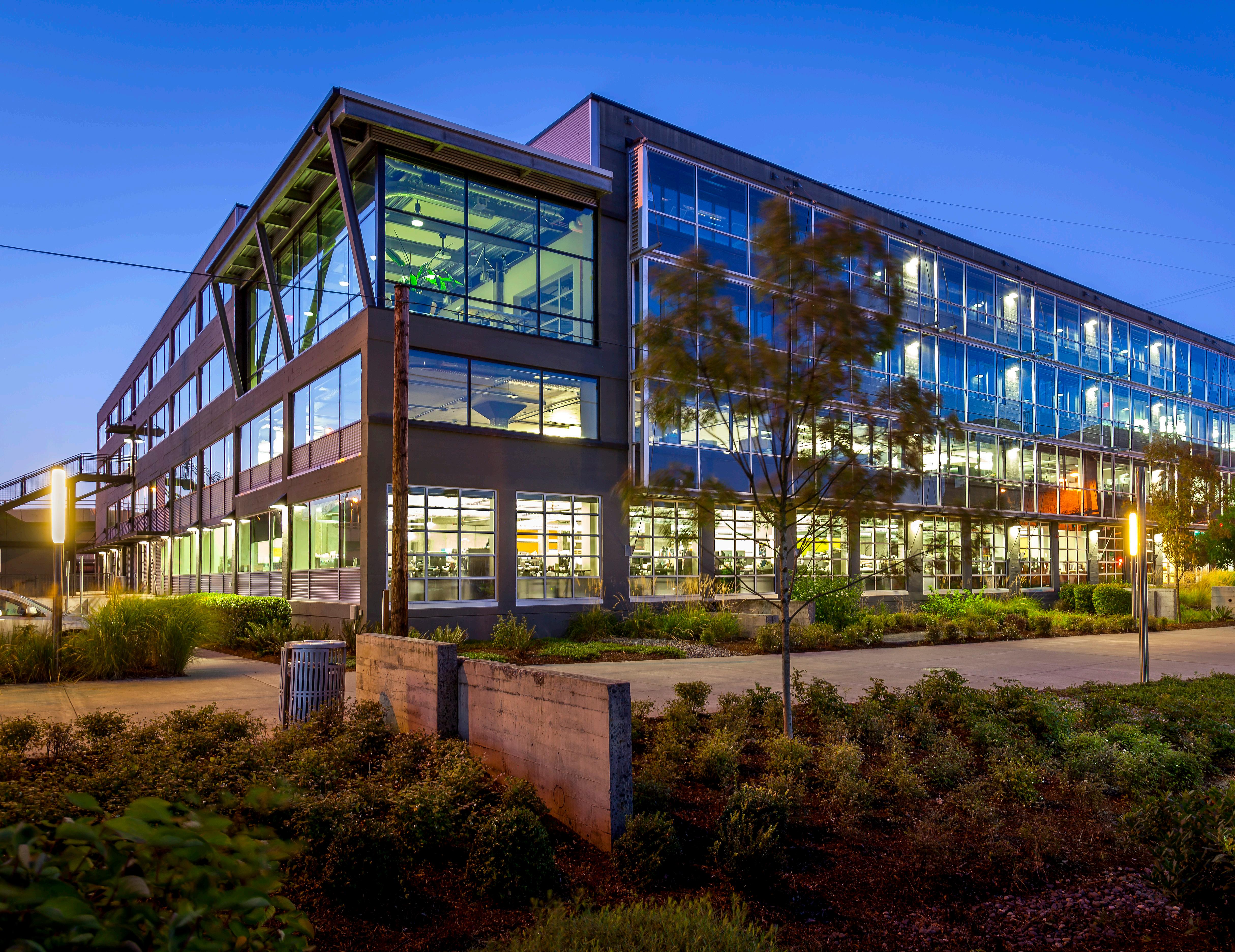

Page 15 Embodied Carbon Action Plan 2024
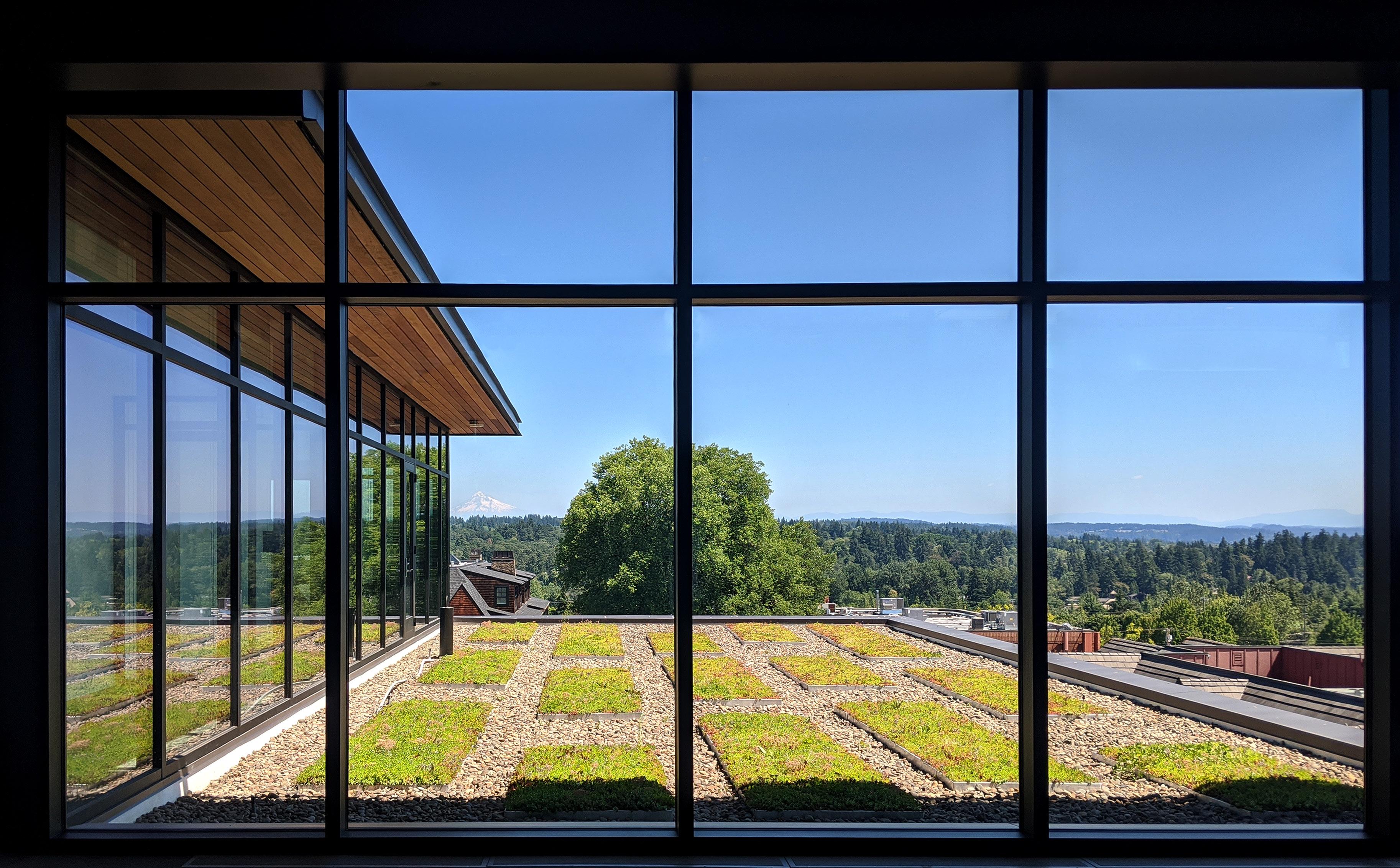
© 2024 Mackenzie Engineering Inc. Unless noted, all text, video recordings, photos, drawings, computer generated images and/or statements are owned by Mackenzie and protected by copyright and/or other intellectual property laws. No part of these pages, either text or image may be reproduced, modified, stored in a retrieval system or retransmitted, in any form or by any means, electronic, mechanical, or otherwise without prior written permission. Mackenzie®, and M.™ and all corresponding logos and designs are service marks and/or registered service marks of Mackenzie Engineering Inc. All rights reserved.



 Jo Ann Offill Embodied Carbon Champion
Jo Ann Offill Embodied Carbon Champion




